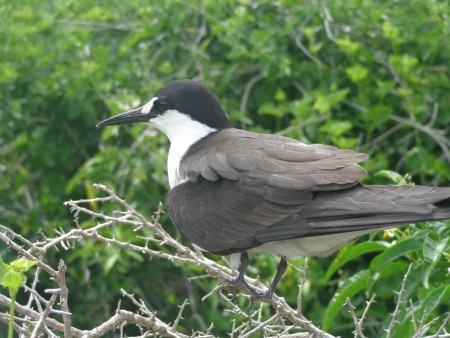
How to spot it:
Known locally as the ‘egg bird’, the Sooty Tern is Anguilla’s most abundant seabird. It is named for its strikingly dark black upperparts, which contrast with white underparts. It has a thin, black bill and legs, long wings and deeply forked tail. A conspicuous white forehead patch extends to the eye. Males and females look similar, even when they are not breeding, and their black napes turn greyish. Juveniles have a blackish-brown head and chest, and upperparts that are speckled with white.
Where to find it:
Sooty Terns occur in tropical oceans, breeding in huge, noisy colonies on rocky islands and cays throughout the equatorial zone. They spend most of their lives over the open ocean, rarely landing. After fledging from their nests, they will not return to land for several years. Between May and August, breeding sooties tend to return to their birthplace, scraping out nests on the ground and laying one egg, sometimes under low-lying scrub vegetation. The best place in Anguilla to see these birds – over 130,000 pairs of them – is on Dog Island, a 205-hectare privately owned offshore cay.
What does it eat?
Wandering over the open ocean, Sooty Terns eat small pelagic fish and squid, grabbing their prey from near the surface of the water and eating while in flight. They often feed over large predatory fish, especially tuna. Fishers often look for flocks of these birds, a sure sign of excellent fishing grounds.
Global status:
Sooty Terns have a large, wide-ranging global population. As with all seabirds, their populations are impacted by threats on water and land. They are especially vulnerable to oil pollution and spills and the reduction of tuna populations as they depend on these larger fish to bring smaller ones to the surface. On land, predation of eggs and chicks by introduced species like rats and cats, egg collecting, and human development on offshore cay nesting habitats has caused serious declines.
